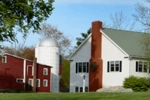HAROLD PARKER STATE FOREST
Harold Parker State Forest, which lies in Andover, North Andover, North Reading and Middleton, comprises just over 3,000 acres of Central Hardwood-Hemlock-White Pine type of forest. The forest is twenty miles north of Boston and within one hour's drive of three million people. Recreational opportunities include hiking, mountain biking, fishing, hunting, horseback riding, swimming, camping and picnicking. The forest has over 35 miles of logging roads and trails and offers quiet seclusion to off-road hikers and bikers. Non-motorized boating is allowed on any of the 11 ponds. No horse, boat or bike rentals are available at the facility.
Lorraine Park Campground, located about 2 miles from the Headquarters on Jenkins Rd., contains 91 sizeable campsites that are spread out sufficiently to provide a real "forest" camping experience. Each site is equipped with a picnic table and a grill, and although no electric or water hookups are available, the bathrooms do have hot water showers. Camping is offered mid-April to mid-October; office hours are from 9am-9pm.
Berry Pond is the area's day use facility, and is open Memorial Day to Labor Day. The pond has a sand beach and new washhouse with flush toilets and changing stalls set against a beautiful backdrop of trees reflected in the surface of the pond. Lifeguards are on duty from 10:00 a.m. to 6:00 p.m. daily. Grills and picnic tables are available for anyone wishing to picnic at Berry Pond.
The forest consists of rolling hills, low lying swampy areas, rock outcrops and several ponds. The landform was created by glacial movement, and evidence of glaciers exists today in the form of glacial erratics. The area was inhabited by Pentacook Indians until it was settled by English farmers around 1650. By the mid-nineteenth century agriculture was abandoned, and a new forest grew up. The sites of an 18th century sawmill and homesteads can be found. Tradition has it that many of the homes surrounding the forest were used as Underground Railroad hideouts in the 1850s. Secret doors and chambers can still be seen in local homes. Frederick Douglass, Harriet Beecher Stowe and William Lloyd Garrison were frequent visitors to families in the area.
Day-UseFishingyes
Huntingyes
Hiking Trailyes
Bike Trailsyes
Swimming Beachyes
Bridle Trailsyes
BoatingLaunch Rampsyes
CampingPrimitiveyes


